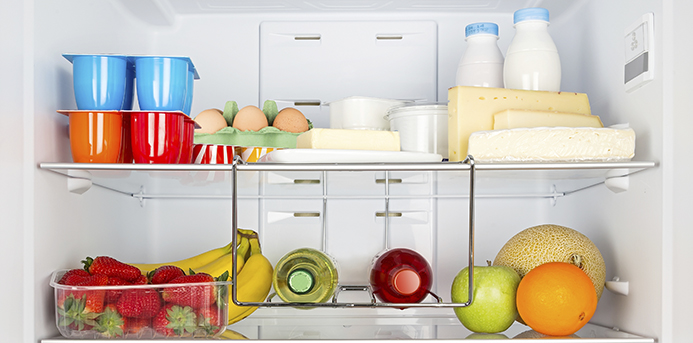“Dense,” said my husband, trying to come up with a compliment for the very healthy, but heavy muffins I had just made. We were 20 minutes into our weeklong experiment, and we were ready to cheat.
Inspired by Michael Pollan—whose book In Defense of Food and recent lecture at Ravinia urge a plant-centered diet—we signed on for one week of eating right. The rules of the game:
1. No processed foods. Five ingredients or less, and we had to be able to pronounce every one.
2. More fruits and vegetables.
3. More whole grains and less white flour, white sugar, white rice.
But could a real family—mom, dad, two teenage sons and one tween daughter—do it?
The first morning, my daughter and I emptied our cupboards and refrigerator. Bye, bye, Honey Bunches of Oats, Life and even Cheerios. So long, Fresca and Goldfish and the light ice cream made with guar gum and 30 other ingredients we couldn’t pronounce.
We were left with really clean cupboards.
I had been searching for recipes that used lots of fruits and vegetables and whole grains, so with everyone waiting for breakfast I started making muffins from a recipe that called for 3 cups of applesauce, whole wheat flour and lots of honey and buttermilk. The small, squishy discs can be blamed for health food’s bad reputation. They tasted awful and had no texture.
“Is this what we’re going to eat all week?” asked a still-starving teenager. I handed him a carrot.
So I started chopping and peeling, reading labels and baking. Reality check—it’s work to cut out processed foods. I had to think more about what I was buying and plan ahead. Here’s what worked for us:
Doubling the vegetables in most recipes. We eat a lot of stews and soups in the winter, and almost every recipe has room for another veggie or adding another cup of carrots or beans.
What’s cut up will get eaten. Monique Ryan, a nutritionist in Evanston, recommends that her clients keep fruit and vegetables in view. Don’t hide the carrots in the veggie drawer, put them in a clear glass container, right in the front.
Whole grains are an easy switch. Basmati brown rice, polenta, whole wheat pasta and whole wheat bread were painless switches from our usual refined carbs. No one even noticed.
Jazz up the veggies. Steamed vegetables are like the girl who sat in the front row of your math class; virtuous but unpopular. Save your vegetables from being voted “Most Likely to Be Good for You.” Serve with hummus or ranch dressing for dipping. Bathe them in a yummy sauce, even one with butter in it. Stir fry them or roast them. Anything to increase their yumminess.
Will we stick with it? Yes. And no. I’m keeping the whole grains and my strategies to up our fruit and vegetable consumption. But processed foods are tougher. We can live without them, but we probably won’t. I need to know that a box of macaroni and cheese or a frozen pizza can save me on a bad night—not every night—but when needed.
We might be healthier with an all-natural diet, but we’re saner because we aren’t too strident. I figure, as long as my kids are eating their veggies, the occasional Oreo isn’t going to hurt.
ROASTED VEGETABLES
Serves: 5 people for three meals (see note below)
Prep time: 15 minutes
Cooking time: 30 minutes
16 cups vegetables cut in chunks
(Recommended favorites: carrots, parsnips, butternut squash, celery root, potatoes, turnips, rutabaga, fennel, kohlrabi)
2 tbsp. olive oil
Kosher or sea salt
1. Preheat oven to 400°.
2. Toss vegetables with olive oil and sprinkle lightly with salt. Spread on one or two baking sheets in a single layer and roast for about 25 minutes.
Cook’s note: The beauty of this recipe is what you can do with all these veggies once you’ve cooked them:
Dice into smaller pieces. Add to garlic sautéed in olive oil and Parmesan cheese for a pasta sauce.
Puree with vegetable broth, ginger and a splash of cream for a delicious soup.
Make a pita sandwich with veggies and hummus.
Add to a stew or soup.
Make a hash with bacon and potatoes.
SIMPLE VINAIGRETTE
Makes: ¾ cup (enough for several salads)
½ cup extra virgin olive oil (the best stuff you’ve got)
¼ cup balsamic vinegar
1 tsp. Dijon mustard
1. Put all ingredients in a jar with a lid. Shake. Add salt and pepper to taste. It will last at least a week in the refrigerator.
Cook’s note: This is divine for all kinds of greens and vegetable salads, but you can use it for many other dishes. Some delicious options include:
Substitute lemon or lime juice for the vinegar and serve over fish.
Toss with pasta and vegetables for a pasta salad.
Use as a marinade for chicken breasts or add a shot of Worcestershire sauce and use to marinade steaks.


